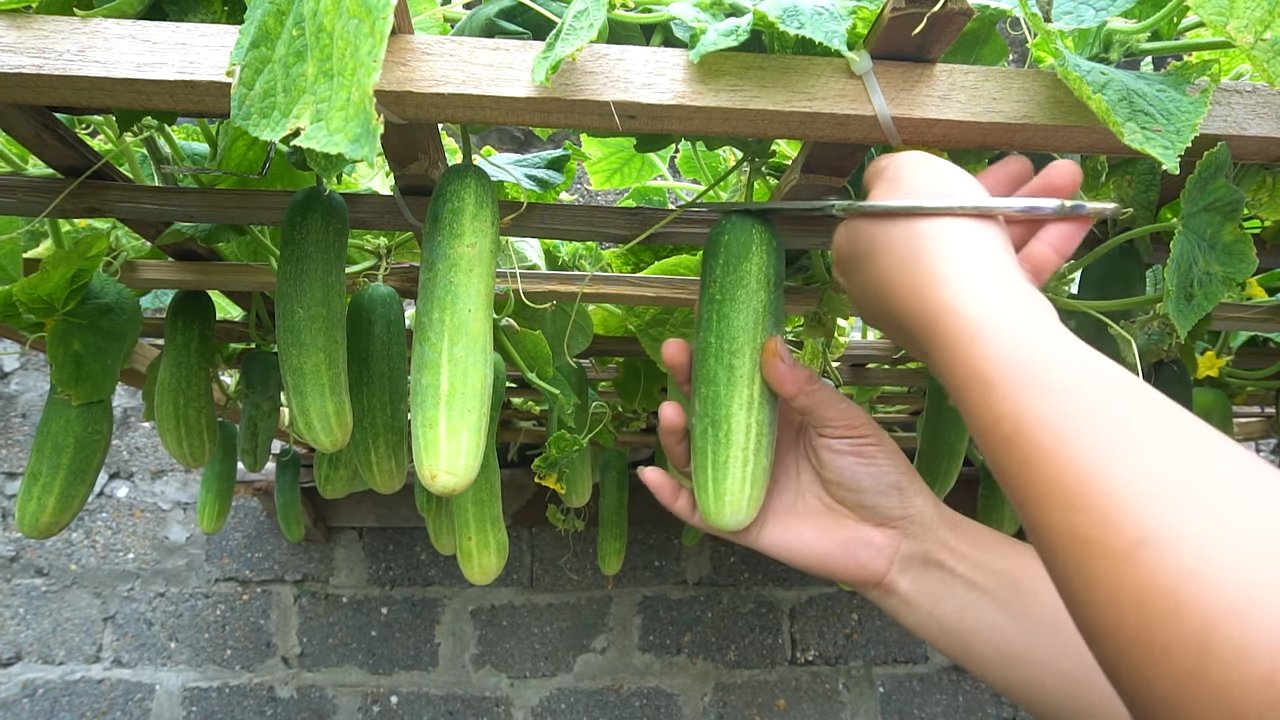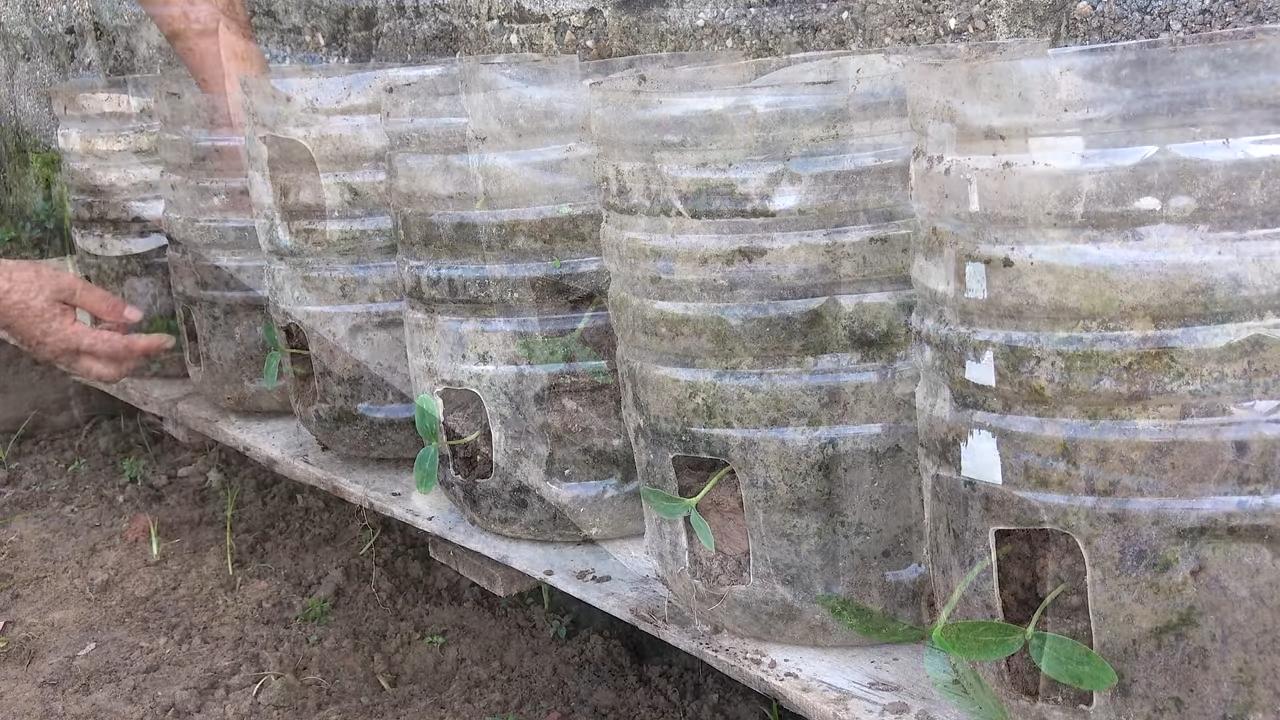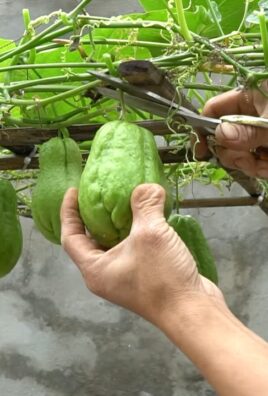Grow cucumbers fast and enjoy the crisp, refreshing taste of homegrown goodness sooner than you ever thought possible! Imagine biting into a juicy cucumber, bursting with flavor, knowing you nurtured it from seed to table in record time. That’s the magic we’re unlocking today with these incredible DIY tricks and hacks.
Cucumbers have a rich history, dating back thousands of years to ancient India. They’ve been prized for their cooling properties and versatility in cuisines around the world. From refreshing salads to tangy pickles, cucumbers are a staple in many cultures. But let’s face it, waiting for them to mature can feel like an eternity!
That’s where these DIY secrets come in. We all lead busy lives, and sometimes patience isn’t our strongest suit. Plus, who wouldn’t want to harvest a bountiful cucumber crop before the summer heat really kicks in? These simple, yet effective, techniques will help you grow cucumbers fast, maximizing your yield and minimizing your wait time. I’m excited to share these tips with you, so you can enjoy the fruits (or rather, vegetables!) of your labor sooner than you think. Let’s get started!

Grow Cucumbers Like a Pro: My Secret DIY Hacks for a Bountiful Harvest!
Okay, cucumber lovers, listen up! I’m about to share my tried-and-true methods for getting those crisp, refreshing cucumbers growing faster than you ever thought possible. Forget waiting all summer – with these DIY hacks, you’ll be swimming in cucumbers in no time! I’ve experimented with these techniques for years, and trust me, they work wonders. Let’s dive in!
Choosing the Right Cucumber Variety
Before we even get our hands dirty, it’s crucial to pick the right cucumber variety. Some are naturally faster growers than others. Here are a few of my favorites:
* Bush Champion: These are compact and perfect for smaller gardens or containers. They mature quickly, usually within 55-60 days.
* Spacemaster: Another great choice for limited space, Spacemaster cucumbers are known for their early and abundant yields. Expect cucumbers in about 60-65 days.
* Sweet Success: This variety is not only delicious but also matures relatively quickly, around 55-60 days. Plus, they’re burpless!
* Early Pride: As the name suggests, this variety is an early producer, typically ready for harvest in about 50-55 days.
Choosing one of these varieties will give you a head start!
Pre-Sprouting for a Head Start
This is one of my favorite tricks! Pre-sprouting cucumber seeds indoors gives them a significant advantage.
Materials You’ll Need:
* Cucumber seeds
* Paper towels
* A resealable plastic bag
* A warm location
Step-by-Step Instructions:
1. Dampen the Paper Towels: Take two paper towels and thoroughly dampen them with water. You want them moist, not soaking wet. Gently squeeze out any excess water.
2. Place Seeds on the Towel: Lay one of the damp paper towels flat. Sprinkle your cucumber seeds evenly across the towel, leaving a little space between each seed.
3. Cover with the Second Towel: Place the second damp paper towel on top of the seeds, covering them completely.
4. Seal in a Plastic Bag: Carefully slide the paper towels with the seeds into a resealable plastic bag. Seal the bag, leaving a small corner slightly open for air circulation.
5. Find a Warm Spot: Place the bag in a warm location, such as on top of your refrigerator or near a radiator. The ideal temperature is around 70-80°F (21-27°C).
6. Check Daily: Check the paper towels daily to ensure they remain moist. If they start to dry out, lightly mist them with water.
7. Wait for Sprouts: Within a few days (usually 2-5), you should see small white sprouts emerging from the seeds. Once the sprouts are about ¼ to ½ inch long, they’re ready to be planted.
Preparing the Soil for Cucumber Success
Cucumbers are heavy feeders, so preparing the soil properly is essential for fast growth.
What Cucumbers Crave:
* Well-draining soil: Cucumbers hate soggy roots.
* Rich in organic matter: This provides essential nutrients.
* Slightly acidic to neutral pH: Aim for a pH of 6.0 to 7.0.
Step-by-Step Soil Preparation:
1. Choose Your Location: Select a sunny spot in your garden that receives at least 6-8 hours of direct sunlight per day.
2. Clear the Area: Remove any weeds, rocks, or debris from the planting area.
3. Amend the Soil: This is where the magic happens! Dig in plenty of organic matter, such as compost, well-rotted manure, or peat moss. I usually add about 3-4 inches of compost to the topsoil.
4. Check the pH: Use a soil testing kit to check the pH level. If the soil is too acidic (below 6.0), add lime to raise the pH. If it’s too alkaline (above 7.0), add sulfur to lower the pH. Follow the instructions on the testing kit and amendment product for proper application rates.
5. Create Mounds or Rows: Cucumbers thrive when planted on mounds or in raised rows. This improves drainage and warms the soil more quickly. Create mounds or rows that are about 6-12 inches high and 2-3 feet apart.
Planting Your Pre-Sprouted Cucumber Seeds
Now for the exciting part – planting those little sprouts!
Step-by-Step Planting Guide:
1. Handle with Care: Gently remove the sprouted seeds from the paper towel. Be extremely careful not to damage the delicate sprouts.
2. Make Small Holes: Create small holes in the prepared soil, about ½ inch deep.
3. Plant the Seeds: Place one sprouted seed in each hole, with the sprout facing upwards.
4. Cover Gently: Lightly cover the seeds with soil.
5. Water Thoroughly: Water the planted seeds gently but thoroughly. Avoid washing away the soil.
6. Mulch Around the Plants: Apply a layer of mulch around the plants to help retain moisture, suppress weeds, and regulate soil temperature. Straw, wood chips, or shredded leaves work well.
Watering and Feeding for Rapid Growth
Consistent watering and feeding are crucial for fast cucumber growth.
Watering Tips:
* Water deeply and regularly: Cucumbers need consistent moisture, especially during hot weather. Water deeply at the base of the plants, avoiding wetting the foliage, which can lead to fungal diseases.
* Check the soil moisture: Stick your finger into the soil to check the moisture level. If the top inch of soil feels dry, it’s time to water.
* Water in the morning: Watering in the morning allows the foliage to dry out during the day, reducing the risk of fungal diseases.
* Use a soaker hose or drip irrigation: These methods deliver water directly to the roots, minimizing water waste and reducing the risk of foliar diseases.
Feeding Schedule:
* Start with a balanced fertilizer: When planting, incorporate a balanced fertilizer (e.g., 10-10-10) into the soil. Follow the instructions on the fertilizer package for proper application rates.
* Side-dress with nitrogen: Cucumbers are heavy nitrogen feeders. Side-dress the plants with a nitrogen-rich fertilizer (e.g., ammonium nitrate or urea) every 2-3 weeks. Sprinkle the fertilizer around the base of the plants and water it in thoroughly.
* Foliar feeding: Consider foliar feeding with a seaweed extract or fish emulsion every 1-2 weeks. This provides essential micronutrients and can boost growth.
Providing Support for Climbing Varieties
If you’re growing climbing cucumber varieties, providing support is essential for maximizing yields and preventing diseases.
Types of Support:
* Trellises: Trellises are a popular choice for supporting cucumbers. They come in various sizes and materials, such as wood, metal, or plastic.
* Cages: Tomato cages can also be used to support cucumber plants, especially bush varieties.
* Fences: If you have a fence, you can train your cucumber plants to climb along it.
* DIY Structures: Get creative and build your own support structure using bamboo poles, branches, or other materials.
Training Your Cucumbers:
* Gently guide the vines: As the cucumber vines grow, gently guide them onto the support structure.
* Tie the vines: Use soft twine or plant ties to secure the vines to the support.
* Prune as needed: Prune any side shoots or leaves that are not producing fruit to improve air circulation and prevent diseases.
The Black Plastic Mulch Trick
This is a game-changer! Black plastic mulch warms the soil faster, promoting quicker germination and growth.
How to Use Black Plastic Mulch:
1. Prepare the Soil: Follow the soil preparation steps outlined earlier.
2. Lay the Plastic: Unroll the black plastic mulch over the prepared soil.
3. Secure the Edges: Secure the edges of the plastic mulch with soil, rocks, or landscape staples.
4. Cut Planting Holes: Cut holes in the plastic mulch where you want to plant your cucumber seeds or transplants.
5. Plant Your Cucumbers: Plant your cucumbers through the holes in the plastic mulch.
Protecting Your Cucumbers from Pests and Diseases
Even with the best care, cucumbers can be susceptible to pests and diseases. Here’s how I protect my crop:
Common Pests:
* Cucumber beetles: These beetles can damage foliage and transmit diseases. Use row covers

Conclusion
So, there you have it! Mastering the art of growing cucumbers fast isn’t some unattainable gardening dream. It’s a tangible reality within your reach, achievable with a few simple, yet impactful, DIY tricks. We’ve explored how optimizing sunlight exposure, nurturing your soil with the right nutrients, and providing consistent watering can dramatically accelerate the growth of your cucumber plants. But the real magic lies in the proactive measures you take to protect your precious vines from pests and diseases.
Why is this DIY approach a must-try? Because it empowers you to take control of your garden’s destiny. Instead of relying solely on commercial fertilizers and pesticides, you’re harnessing the power of natural methods to cultivate healthy, thriving cucumber plants. This not only results in a bountiful harvest of crisp, delicious cucumbers but also contributes to a more sustainable and eco-friendly gardening practice. Imagine the satisfaction of biting into a cucumber you’ve nurtured from seed to fruit, knowing that you’ve done so with minimal environmental impact.
Beyond the core techniques we’ve discussed, there’s a world of variations you can explore to further personalize your cucumber-growing journey. Consider experimenting with companion planting. Marigolds, for instance, are known to deter pests, while dill can attract beneficial insects that prey on aphids. You could also try different trellising methods to maximize vertical space and improve air circulation around your plants. Some gardeners even swear by Epsom salt solutions to boost magnesium levels and enhance fruit production. The possibilities are endless!
Remember, gardening is a journey of continuous learning and experimentation. Don’t be afraid to try new things, observe your plants closely, and adapt your approach as needed. The key is to stay engaged, be patient, and enjoy the process.
We are confident that by implementing these DIY tricks, you’ll be amazed at how quickly you can grow cucumbers. But don’t just take our word for it. We encourage you to put these techniques into practice and witness the results firsthand. And most importantly, we want to hear about your experiences! Share your successes, your challenges, and any variations you’ve discovered in the comments below. Let’s create a community of cucumber-growing enthusiasts, sharing knowledge and inspiring each other to achieve even greater gardening feats. So, grab your gardening gloves, prepare your soil, and get ready to enjoy a summer filled with an abundance of homegrown cucumbers! Happy gardening!
Frequently Asked Questions (FAQ)
Q: How much sunlight do cucumbers really need to grow fast?
A: Cucumbers are sun-loving plants, and adequate sunlight is crucial for their rapid growth. Aim for at least 6-8 hours of direct sunlight per day. If you live in a particularly hot climate, some afternoon shade can be beneficial to prevent scorching. If you’re growing cucumbers indoors, consider using grow lights to supplement natural sunlight, especially during the shorter days of the year. The intensity and duration of light exposure directly impact the plant’s ability to photosynthesize, which is the process by which it converts sunlight into energy for growth. Insufficient sunlight will result in slow growth, weak stems, and reduced fruit production.
Q: What’s the best type of soil for growing cucumbers quickly?
A: Cucumbers thrive in well-draining, fertile soil that is rich in organic matter. The ideal soil pH should be between 6.0 and 7.0. Before planting, amend your soil with compost, aged manure, or other organic materials to improve its structure, drainage, and nutrient content. Avoid heavy clay soils, as they tend to retain too much water and can lead to root rot. If you have clay soil, consider adding sand and organic matter to improve its drainage. A soil test can help you determine the pH and nutrient levels of your soil, allowing you to make necessary adjustments before planting.
Q: How often should I water my cucumber plants to promote fast growth?
A: Consistent watering is essential for growing cucumbers fast. Cucumbers need about 1 inch of water per week, especially during hot, dry weather. Water deeply and regularly, aiming to keep the soil consistently moist but not waterlogged. Avoid overhead watering, as this can increase the risk of fungal diseases. Instead, water at the base of the plants, using a soaker hose or drip irrigation system. Mulching around the plants can help retain moisture in the soil and reduce the need for frequent watering. Check the soil moisture regularly by sticking your finger about an inch into the soil. If it feels dry, it’s time to water.
Q: What are some common pests and diseases that can slow down cucumber growth, and how can I prevent them?
A: Cucumbers are susceptible to several pests and diseases, including aphids, cucumber beetles, squash bugs, powdery mildew, and downy mildew. To prevent these problems, practice good garden hygiene, such as removing weeds and debris that can harbor pests and diseases. Inspect your plants regularly for signs of infestation or disease, and take action promptly if you spot any problems. Use organic pest control methods, such as insecticidal soap or neem oil, to control aphids and other pests. To prevent fungal diseases, ensure good air circulation around your plants, avoid overhead watering, and apply a fungicide if necessary. Companion planting with marigolds or nasturtiums can also help deter pests.
Q: Can I use fertilizer to help my cucumbers grow faster? If so, what kind and how often?
A: Yes, fertilizing your cucumber plants can significantly boost their growth and fruit production. Use a balanced fertilizer with equal amounts of nitrogen, phosphorus, and potassium (e.g., 10-10-10) or a fertilizer specifically formulated for vegetables. Apply fertilizer according to the package instructions, typically every 2-3 weeks during the growing season. Avoid over-fertilizing, as this can lead to excessive foliage growth at the expense of fruit production. You can also supplement with organic fertilizers, such as compost tea or fish emulsion, to provide additional nutrients and beneficial microbes to the soil.
Q: How important is trellising for growing cucumbers fast?
A: Trellising is highly beneficial for growing cucumbers fast and efficiently. It provides support for the vines, allowing them to grow vertically and maximizing space in your garden. Trellising also improves air circulation around the plants, reducing the risk of fungal diseases. Furthermore, it makes it easier to harvest the cucumbers, as they are more visible and accessible. There are various trellising options available, including A-frame trellises, vertical trellises, and even simple stakes. Choose a trellising method that suits your garden space and the type of cucumber you are growing.
Q: What are some cucumber varieties that are known for their fast growth and early yields?
A: Several cucumber varieties are known for their fast growth and early yields, making them ideal for gardeners who want to harvest cucumbers quickly. Some popular choices include ‘Spacemaster,’ ‘Bush Champion,’ ‘Early Pride,’ and ‘Sweet Success.’ These varieties are typically compact and productive, producing a good crop of cucumbers in a relatively short amount of time. When selecting a cucumber variety, consider your local climate, growing conditions, and personal preferences.
Q: How do I know when my cucumbers are ready to harvest?
A: Cucumbers are typically ready to harvest when they reach the desired size and color for their specific variety. The skin should be firm and smooth, and the cucumber should feel heavy for its size. Avoid letting the cucumbers become too large or overripe, as they can become bitter and seedy. Harvest cucumbers regularly to encourage continued fruit production. Use a sharp knife or pruning shears to cut the cucumber from the vine, leaving a short stem attached.




Leave a Comment